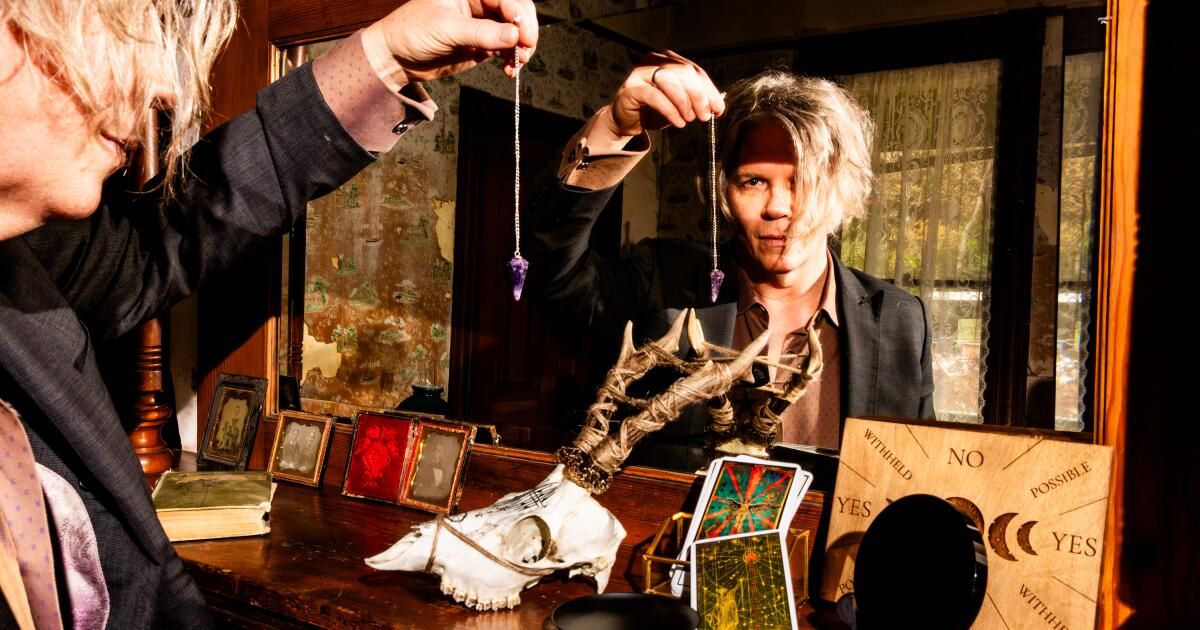I am sitting in a tent placed inside the living room of the Victorian era. Before me there is a spirit board, a lone tarot letter and a black tap mirror. I am here to communicate with the dead.
There is no means. We are only me and eight other attendees: our guide has left the store. Although we could hear the tension music before establishing a cryptic mood, now there is nothing. Lights? Off. The store has become black. In this particular moment, there is only the sound of our breaths, our thoughts and perhaps some new guests.
Welcome to “PhasMagorica”, which the composer turned into magnate-magnificent spiritual explorer BC Smith describes as “a reimited Séance as art.” It runs this month at the Heritage Square Museum, in itself an imbued location of history and mystery, the site of the Los Angeles houses as they existed a century ago.
I will arrive directly to the point: I did not have an encounter with the dead. And yet, I left “Phasmagorica” deeply curious. This is because Smith establishes the night as an exploration of the modern western history of communicating with the deceased, trying to conjure the feeling of a session as happened at the end of the 1880s, although with a better sound system and all death in the afternoon cocktails that it can consume (keep in mind: it should not consume many).
The “experiment”, Smith Shirks for the word performance, is designed, says, for believers and non -believers. He himself falls somewhere in the middle.
“I am a hopeful skeptic,” says Smith. “If I were a 100%believer, 'Phasmagorica' would be a church. I just wanted to create a space that started a conversation for people.”
It is relevant to point out that Smith is also a magician, a member of the Magic Castle, Hogar himself for a popular Séance. While Smith has not carried out a magical castle, he has, and will do, orchestra to what he refers to as a “theatrical welfare”, for which he is present as a narrator. “Phasmagorica” is different, says Smith, and was born from those most dramatic performances, partly because he continued to find the inexplicable.
“It is very cured,” says Smith about a central difference between a theatrical and “Phasmagoric” everness, since the first will adapt specifically to the needs and requests of the guests. “But people were experiencing a lot in those sessions that I couldn't explain,” says Smith. It recites a story that opens “Phasmagorica” of a shadow that extends and touches someone on one shoulder. Smith says he witnessed this phenomenon, and at that time he decided to create an event that focused on realism and dispensed with the notion that there could be illusions or magic.
“Phasmagorica” of BC Smith is not a theatrical or magical performance. The event aims to recreate the feeling of a vintage seanance.
(Roger Kisby / For the Times)
I was surprised, for example, when Smith left the room. At that time, we were alone with a TV, which tells a brief history of sessions in the United States before instructing us to celebrate a pendulum on a spiritual joint. Knowing Smith's past, I entered waiting more a show. Instead, we are driven to examine a tarot card, look in the Scrying mirror and ask our spirit board.
“It becomes more personal,” says Smith. “Even in my theatrical sessions, I have had people who want to separate me in the middle of the prayer and say: 'This simply happened to me.' And they want to spend the next five minutes talking about it.
And yet, Smith says, the public is looking for magic. But there are no light tricks, there are no hidden fans. He emphasizes several times in this interview and at the beginning of “Phasmagorica” that this is not “no theater, not a performance, not a show.”
“I have made people get out of the room and swear there was a magnet on the pendulum board,” he says. “Or swear that there was some effect that made them see a person standing. People still have an explanation that they had something to do with that. Whatever help you sleep with the light.”
While numerous cultures and spiritual movements throughout history have tried for a long time to communicate with the dead, a Séance, says Lisa Morton, author of “calling spirits: a history of sessions”, is a relatively recent fact. She and Smith track their popularity with the Fox, Kate and Maggie sisters, who acted to crowds packed in the end of the 1880s in New York, trying to demonstrate that the spirits could speak through a series of raps on the walls.


BC Smith calls “phasmagorica” an “experiment”, avoid the word performance. (Roger Kisby / For the Times)
Before the Fox sisters, says Morton, attempts to communicate with the hereafter, in general terms, were a more personal and ritualist issue. “The Greeks believed that sleeping in a grave could give you dreams in which you communicate with a spirit,” she says. Popular myths would also portray practice as an arcane limit. In “The Odyssey” of Homer, for example, a bridge to the spiritual world is reached only after a complex series of sacrifices and offerings: a powerful mixture of sweet wine and the blood of a lamb.
“The session occurs, and it is not only a group activity, but suggests that anyone can communicate with the spirits of the dead,” says Morton. “He only needs a medium: someone who can enter a state of trance and open to receive spiritual communications. He took a group and in the comfort of someone's house. Those were surprisingly new ideas.”
Morton has participated in “Phasmagorica” by Smith. She also appreciated the historical emphasis, specifically the way a musician acts after the Séance while the guests mix with each other and share their experience. Music was a large part of the first sessions, says Morton.
“People would sit around a table and the lights would go down and sing,” says Morton, “Singing had a double scammed purpose, since they allowed the half to begin doing things in unbuilded darkness. But these nights were wonderful for people, and I thought that was what BC Smith captured really well.”
“Phasmagorica” has been operating on Select weekends in Heritage Square since the end of summer. Smith intends to continue adding events throughout the fall as allowed by his schedule, announcing them on Instagram. Although intimate, they are usually exhausted. He travels from mouth to mouth, theorizes Smith, because today's people are increasingly looking for “connection and meaning.”

Heritage Square Museum is in itself an imbued location of history and mystery, the site of the Los Angeles Houses, as existed a century ago.
(Marcus Ubungen / Los Angeles Times)
“The experience really depends on you,” he says. “I think we are all looking for something. This is a safe space to explore.”
At the end of life, Maggie Fox denounced the spiritual movement that she and her sister Kate had helped begin, demonstrating the ways in which they had cheated their audience. Smith again emphasizes that he is a “hopeful skeptic”, and the purpose remains out of experience so that the guests are not trying to find out if he is holding on to any secret.
And yet, he says: “Phasmagorica” has changed it permanently. He points out that his wife is a pilot of a commercial airline and must often travel.
“When she is out, I sleep with a night light,” he says. “Maybe that is the answer to the question whether or not I believe.”












